
| KIT #: | A07114 |
| PRICE: | $35.00 |
| DECALS: | Two options |
| REVIEWER: | Tom Cleaver |
| NOTES: | Three Guys Replicas decals “Ju-87B Stukas” TGR48005 |

| HISTORY |
The Ju-87 Stuka was the best-known German airplane during the early years of World War II, due to it’s use in the Blitzkrieg that swept continental Europe in 1939-40.
Designed by Hermann Pohlmann, to meet a RLM requirement for a Sturzkampfflugzeug (“diving war plane”)the Ju-87 first flew in 1935 and made its combat debut in 1937 with the Condor Legion during the Spanish Civil War. The development of the Stuka only came about due to the personal support of the concept of a divebomber by Ernst Udet after he became head of the Luftwaffe’s technical branch, responsible for aircraft development. Known as the “Stuka” - a diminutive of the design type, the aircraft involved several innovative features, including automatic pull-up controls to ensure that the aircraft recovered from its attack dive even if the pilot blacked out from the high g-forces. The Ju-87B - the “classic” Stuka - entered production in 1938.
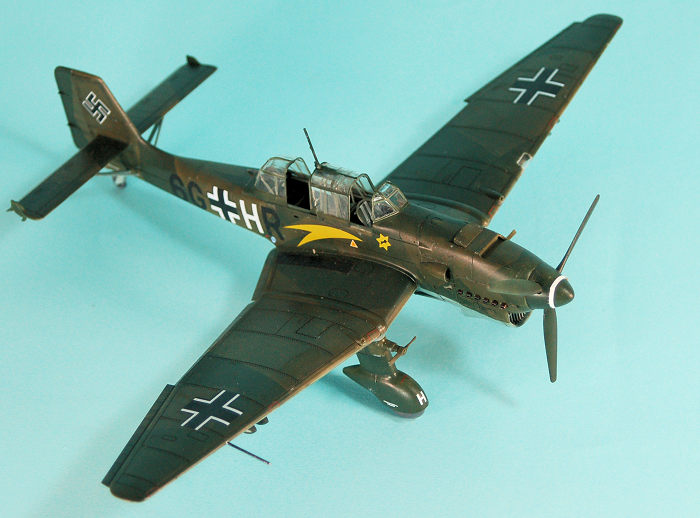 The Ju-87B series was the first mass-produced variant. Six
pre-production Ju-87B-0 were produced. The first production version was the Ju
87 B-1, with a Junkers Jumo 211D generating 1,184 hp. The airframe differed from
the Ju-87A with a completely redesigned fuselage and landing gear, replacing the
twin radio masts of the "A" version with a single mast mounted further forward
on the "greenhouse" canopy, and much simpler, lighter-weight wheel "spats" that
discarded the transverse strut bracing of the "A" version's maingear design and
the large “pants” around the landing gear. By the outbreak of World War II, the
Luftwaffe had 336 Ju 87 B-1s on hand. The B-1 was fitted with "Jericho
trumpets", propeller-driven sirens mounted on the wing's leading edge directly
forward of the landing gear. This was used to weaken enemy morale and enhance
the intimidation of dive-bombing. After the enemy became used to it, however,
they were withdrawn. The devices caused a loss of some 10-20 mph through drag.
Instead, some bombs were fitted with whistles on the fin to produce the noise
after release.
The Ju-87B series was the first mass-produced variant. Six
pre-production Ju-87B-0 were produced. The first production version was the Ju
87 B-1, with a Junkers Jumo 211D generating 1,184 hp. The airframe differed from
the Ju-87A with a completely redesigned fuselage and landing gear, replacing the
twin radio masts of the "A" version with a single mast mounted further forward
on the "greenhouse" canopy, and much simpler, lighter-weight wheel "spats" that
discarded the transverse strut bracing of the "A" version's maingear design and
the large “pants” around the landing gear. By the outbreak of World War II, the
Luftwaffe had 336 Ju 87 B-1s on hand. The B-1 was fitted with "Jericho
trumpets", propeller-driven sirens mounted on the wing's leading edge directly
forward of the landing gear. This was used to weaken enemy morale and enhance
the intimidation of dive-bombing. After the enemy became used to it, however,
they were withdrawn. The devices caused a loss of some 10-20 mph through drag.
Instead, some bombs were fitted with whistles on the fin to produce the noise
after release.
The Ju-87B was very successful in the close air support and anti-shipping role at the outbreak of World War II. It spearheaded Nazi assaults in the Invasion of Poland in September 1939 and the Norwegian Campaign in the following year. The Stukas had numerous successes against the Royal Navy. The heavy cruiser HMS Suffolk was attacked on 17 April. Her stern was nearly destroyed, but she limped back to Scapa Flow with 33 dead and 38 wounded crewmen. The light cruisers HMS Curacoa and Curlew were subjected to attacks which badly damaged the former for one Ju-87 lost. A witness later said, "they threatened to take our masthead with them in every screaming nerve-racking dive". After these and other attacks, the Royal Navy issued an order that no ship was to operate within range of the Ju-87's Norwegian airfields. The Stuka had driven British sea power from the Norwegian coast.
In May 1940, Ju-87s were crucial in the rapid conquest of the
Netherlands, Belgium and France against all targets. The Stuka neutralized the
fortress of Eben Emael, Belgium when they destroyed the hea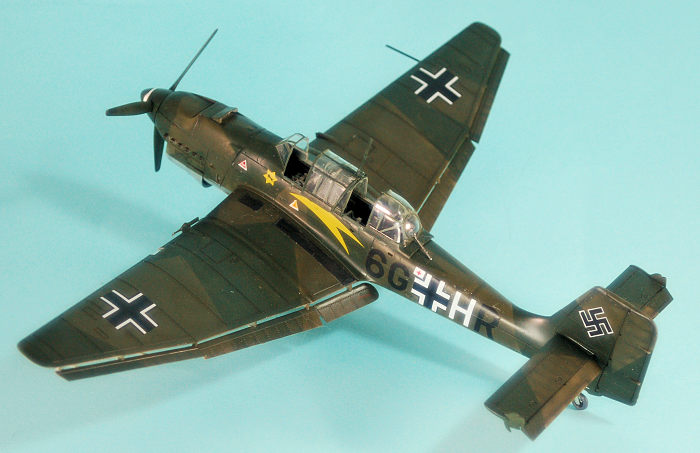 dquarters of the
commander responsible for ordering the destruction of the Belgian Army-held
bridges along the Albert Canal was stationed in the village of Lanaken and
leveled the small building with four direct hits. As a result, only one of the
three bridges was destroyed which allowing a rapid advance in the opening days
of the Battle of Belgium. In pitched battles against French armored forces at
Hannut and Gembloux Ju-87s effectively neutralized artillery and armor. At
Dunkirk, Stukas were responsible for nearly all British shipping losses. The
merchant ship Fenella was sunk after taking on 600 soldiers. The attacks brought
the evacuation to a halt for a time.
dquarters of the
commander responsible for ordering the destruction of the Belgian Army-held
bridges along the Albert Canal was stationed in the village of Lanaken and
leveled the small building with four direct hits. As a result, only one of the
three bridges was destroyed which allowing a rapid advance in the opening days
of the Battle of Belgium. In pitched battles against French armored forces at
Hannut and Gembloux Ju-87s effectively neutralized artillery and armor. At
Dunkirk, Stukas were responsible for nearly all British shipping losses. The
merchant ship Fenella was sunk after taking on 600 soldiers. The attacks brought
the evacuation to a halt for a time.
Although it was sturdy, accurate, and very effective against ground targets, like many other dive bombers of the war, it was vulnerable to modern fighter aircraft, as was demonstrated on a few occasions during the Battle of France when unescorted Stuka squadrons suffered high losses.
During the Battle of Britain the Stuka performed outstandingly during the Channel Battle at the beginning, sinking numerous ships. Three Stuka Geschwadern were committed to the battle. On 13 August,Bf-109Es of JG 26 were sent out in advance of the main strike and successfully drew off RAF fighters, which allowed 86 Ju-87s of StG 1 to attack RAF Detling in Kent unhindered. The attack killed the station commander, destroyed 20 RAF aircraft on the ground and a great many of the airfield's buildings. A lack of maneuverability, speed and defensive armament meant that the Ju-87 required a heavy fighter escort to operate effectively, however, the Stuka was difficult for escorts to stay with due to its low speed.
On 18 August, known as “the Hardest Day” because both sides suffered heavy losses, the Stuka was withdrawn after 16 were destroyed and many others damaged.According to the Generalquartiermeister der Luftwaffe, 59 Stukas had been destroyed and 33 damaged to varying degrees in six weeks of operations. Over 20 percent of the total Stuka strength had been lost between 8 and 18 August; the myth of the Stuka had been shattered. Ju-87s did succeed in sinking six warships, 14 merchant ships, badly damaging seven airfields and three Chain Home radar stations, and destroying 49 British aircraft, mainly on the ground.
The Stuka went on to great success in the Balkans
campaign and was a deadly ship-killer in the Mediterranean, where it was
responsible for sinking HMS Eagle among
many other warships, and severely damaging HMS Illustrious
as well as other British aircraft carriers and other warships. It was
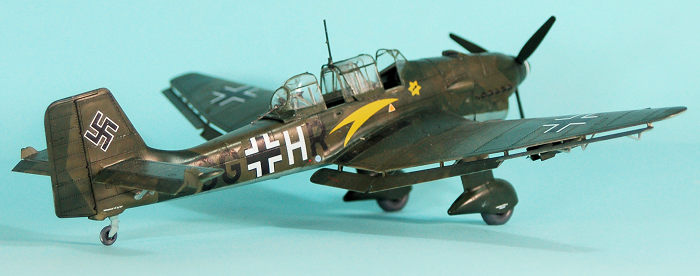 also
operated by the Regia Aeronautica,
where it was known as the Picciatello.
also
operated by the Regia Aeronautica,
where it was known as the Picciatello.
Stukas were particularly successful during the Battle of Crete. On 21–22 May 1941, the Germans lost 10 vessels to the Royal Navy’s "Force D", consisting of the cruisers HMS Dido, Orion and Ajax, forced the remaining German ships to retreat. Stukas were called upon to deal with the British naval threat. On 21 May, the destroyer HMS Juno was sunk and the next day the battleship HMS Warspite was damaged and the cruiser HMS Gloucester was sunk, with the loss of 45 officers and 648 ratings. Stukas also crippled HMS Fiji that morning, while sinking the destroyer HMS Greyhound with one hit. On 23 May, the Royal Navy lost the destroyers HMS Kashmir and Kelly, followed by HMS Hereward on 26 May; Orion and Dido were also severely damaged. Orion had been evacuating 1,100 soldiers to North Africa; 260 of them were killed and another 280 wounded.
The Ju-87B’s final success was in the Soviet Union during Operation Barbarossa. A demonstration of the Stuka's effectiveness occurred on 5 July, when StG 77 knocked out 18 trains and 500 vehicles. On 13 September, Stukas from StG 1 destroyed the rail network in the vicinity as well as inflicting heavy casualties on escaping Red Army columns, for the loss of just one Ju-87. On 23 September, StG 2's Hans-Ulrich Rudel sank the Soviet battleship Marat with a hit to the bow with a single 1,000 kg bomb. Leutnant Egbert Jaeckel sank the destroyer Minsk, while the destroyer Steregushchiy and submarine M-74 were also sunk. The Stukas also crippled the battleship Oktyabrskaya Revolutsiya and the destroyers Silnyy and Grozyashchiy; only two Stukas were shot down.
| THE KIT |
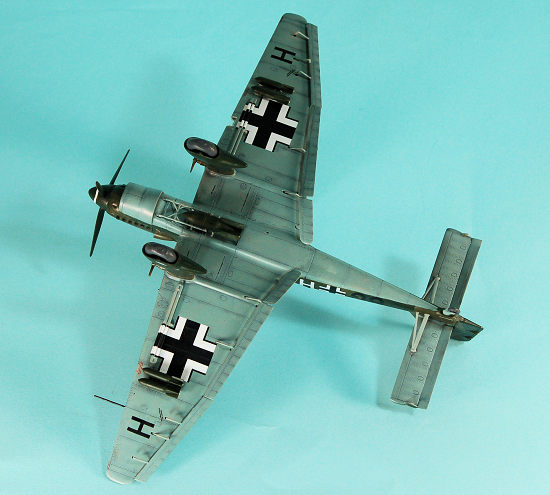 Airfix released a 1/48 Ju-87B-2 around 1980, which was very good for its
time and still makes up into a nice model; in fact, the raised rivet detail on
this kit makes it the only really accurate Stuka kit out there - the J-87 was a
mass of raised rivets.
Airfix released a 1/48 Ju-87B-2 around 1980, which was very good for its
time and still makes up into a nice model; in fact, the raised rivet detail on
this kit makes it the only really accurate Stuka kit out there - the J-87 was a
mass of raised rivets.
This updated kit does not have the raised detail, opting for the more “commercially acceptable” engraved details modelers believe all airplanes are constructed with.
The kit includes a Jumo 211 engine that can be displayed with the cowling off. While this release is for the early Ju-87B-1 version, all the parts necessary to build a Ju-87B-2 or a Ju-87R are also present on the sprues. Decals are provided for a Condor Legion Stuka and a Battle of Britain aircraft.
| CONSTRUCTION |
The kit is thoroughly “new Airfix.” Close fit requires that one clean off all sprue nubs. Good production design insures and easy build for those willing to commit the revolutionary act of actually reading and following the very good instructions. The one really awful part of the kit is the clear canopy - more on that later.
Following the instructions, I decided to build my kit with the cowling closed.
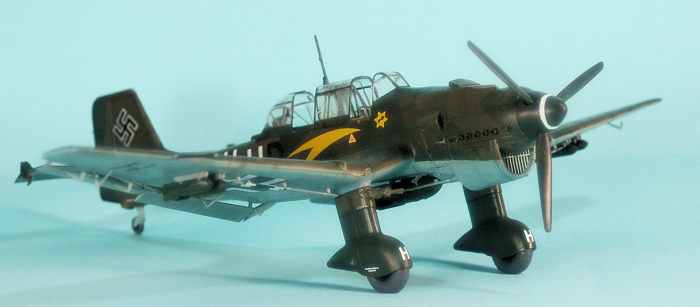 I began by painting and detailing the cockpit, where I used Eduard seat
belts to improve the look. I followed the assembly instructions and completed
the fuselage, then slipped the cockpit assembly inside without problem.
I began by painting and detailing the cockpit, where I used Eduard seat
belts to improve the look. I followed the assembly instructions and completed
the fuselage, then slipped the cockpit assembly inside without problem.
Airfix provides a very nice internal structure for the wing sub assembly, which guarantees everything is properly aligned. After mating fuselage and wing, I attached the horizontal stabilizers and the engine cowling. I then assembled the landing gear and decided to use the “Jericho trumpets” just because I hadn’t built a Stuka model with those before.
The model was painted in 70/71/65 splinter camouflage using Tamiya paints. I dug the Three Guys Replicas Stuka decals out of the decal dungeon because I liked the “comet” markings the sheet included.
| FINAL CONSTRUCTION |
I attached the prop, landing gear and bombs. Then came the battle of the canopy.
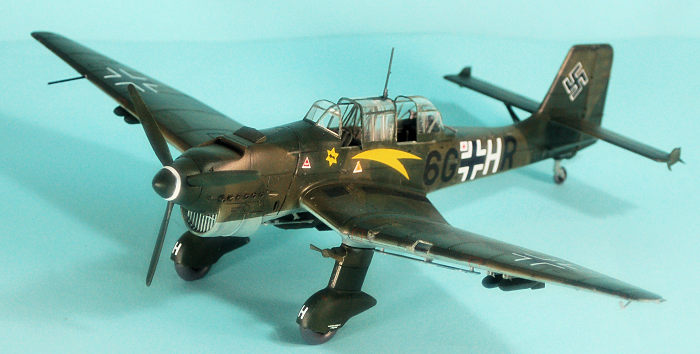 The canopy correctly shows the interior bracing. Unfortunately, this is
done very heavy-handed. The kit provides an “open” option in which the pilot’s
canopy and the center part are molded as one piece; however, this means one
cannot get the interior bracing done accurately. The alternative is to close
things up, but the canopy is thick and distorts vision through it, which means
the work done inside is lost.
The canopy correctly shows the interior bracing. Unfortunately, this is
done very heavy-handed. The kit provides an “open” option in which the pilot’s
canopy and the center part are molded as one piece; however, this means one
cannot get the interior bracing done accurately. The alternative is to close
things up, but the canopy is thick and distorts vision through it, which means
the work done inside is lost.
I ended up cutting the “closed” option apart. I then carefully scraped down the heavy internal bracing without scraping the glass, which I then painted inside. I cut down the center section so the pilot’s canopy could sit atop it. With all this, I was able to assemble the canopies in the open position.
| CONCLUSIONS |
The kit is very nice. Design is such that whether one has been modeling for 50 years or is building their second kit, the assembly is easy and results in an accurate model - again, following the instructions has a good result.
The canopy is the killer. For those who decide to do the closed option (the only one really accurate out of the box), this means you don’t have to do a lot of work detailing the cockpit since you won’t see it. Sadly, Squadron no longer carries the Falcon vacuform canopy for the old Airfix kit, which would be perfect here. Falcon does have the canopy in one of their Luftwaffe canopy sets, and it is well worth obtaining if you are determined to open things up. Those with firm hands and good hand-eye coordination can do what I did.
Overall, the nicest early Stuka out there and the only one that provides the parts for a Ju-87B-1. The price is good too. Airfix has another kit worth picking up. Yay! Airfix is back!!
9 March 2017 Copyright ModelingMadness.com Thanks to Hornby USA for the review
kit. If you would like your product reviewed fairly and fairly quickly, please
contact
the editor or see other details in the
Note to
Contributors.
Back to the Main Page
Back to the Review
Index Page
Back to the Previews Index Page